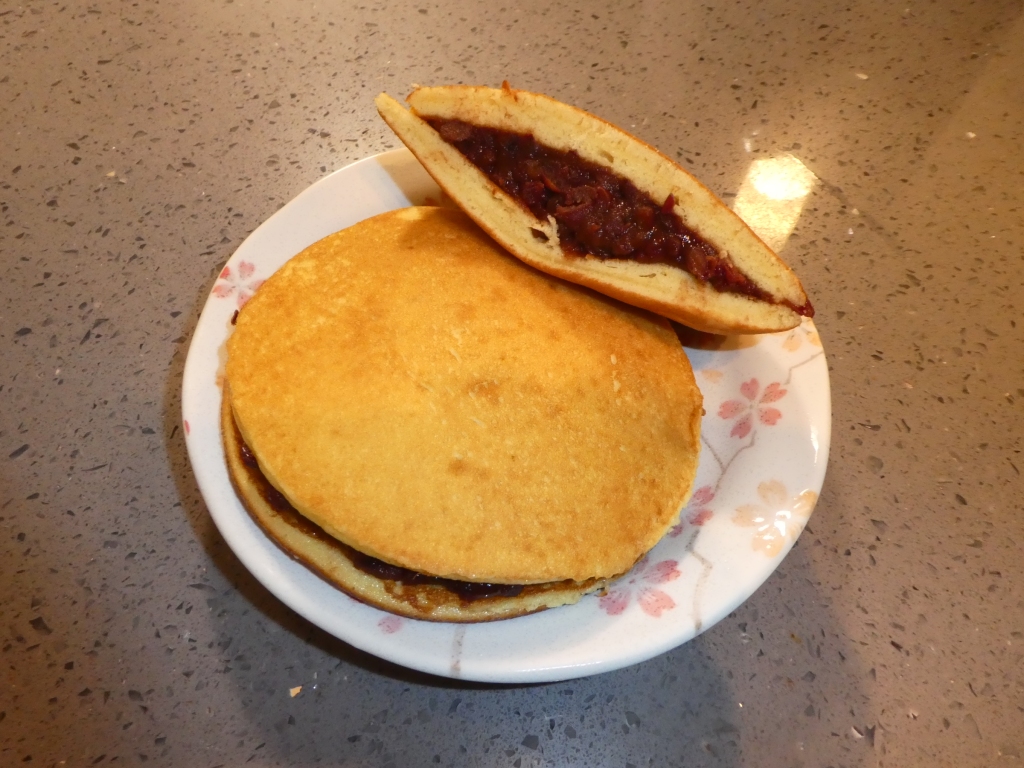
These dorayaki (Japanese), tong luo shao (Chinese), a.k.a red bean paste pancake sandwiches, are very tasty, especially if you like honey-flavored pancakes and red bean paste. If you want them to look perfectly uniformly golden-brown, then you need a very good nonstick pan. Otherwise, you can make them as you normally cook pancakes and they’ll taste just as good.
Dorayaki (Red Bean Paste Pancake Sandwiches)
From Just One Cookbook
Yield: 6 dorayaki
- 4 large eggs (50 g each w/o shell)
- 140 g sugar
- 2 Tbsp honey
- 160 g all-purpose flour
- 1 teaspoon baking powder
- 1-2 tablespoons water
- Neutral-flavored oil, such as vegetable, rice bran, canola, etc. for greasing the pan
- 520 g red bean paste
- In a large mixing bowl, whisk together eggs, sugar, and honey until well combined.
- Whisk in baking powder, then sift flour into the mixture. Whisk until combined.
- Cover and chill in the refrigerator for 15 minutes.
- The batter will look more smooth now. Whisk it again, then whisk in 1-2 tablespoons of water so that when you lift your whisk, the batter falls back into the bowl in loose ribbons. (I recommend watching the video to check the consistency.)
- Heat a large nonstick pan on medium-low, nearly low, heat for about 5 minutes. You need to use a good nonstick pan, or the pancakes will stick to bottom. You also don’t want the pan to get too hot.
- When the pan is preheated, dip a paper towel in oil and coat the bottom of the pan. Then use a clean paper towel to basically wipe off all the oil. That will enable you to get uniformly golden-brown pancakes.
- Using a 1/4-cup measuring cup, pour 3 tablespoons batter into the pan from about 3″ above the pan. The batter will spread into a 3″ circle.
- Cook until the surface of the batter just starts to bubble, then flip and cook the other side. The timing will depend a lot on your stove and pan, so watch it closely and experiment. Don’t get too frustrated if you end up throwing out the first couple pancakes.
- Transfer cooked pancake to a plate and cover with a damp towel to prevent it from drying out.
- Make the remaining pancakes in the same way. If your nonstick pan is good enough, you won’t need to re-oil the pan between pancakes. (If it’s not good enough, like mine, just use more oil; the pancakes will look splotchy but still taste good.) You should get about 12 pancakes total.
- Divide red bean paste into 6 equal portions. Spread it across 6 pancakes, mounding more in the centers so the dorayaki will be fatter there. Sandwich the red bean paste with the remaining pancakes.
- Wrap dorayaki in plastic wrap until ready to serve. Wrapped, they can be kept in the refrigerator for up to 2 days or frozen in a freezer bag up to 1 month.

